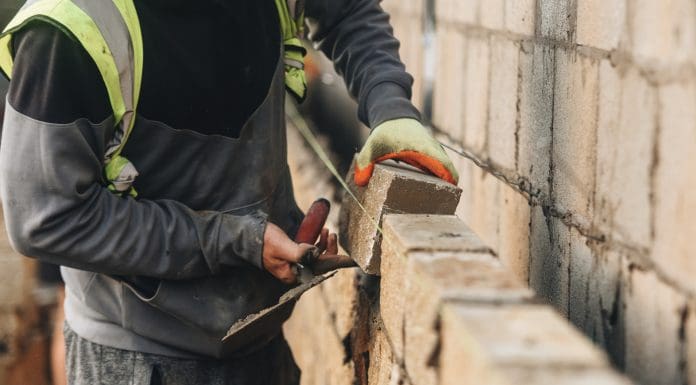
PBC Today sat down with Keith Aldis, the chairman of the Masonry Association of Great Britain, to discuss the state of the sector and what support is needed
Keith Aldis was appointed the chairman of the MAGB in October, and is working to build cooperation in the sector and among association members.
MAGB is one of the leading associations for UK masonry, and acts to support the sector and both give members a voice to, and work with the government.
1. How would you describe the current state of the masonry industry in the UK, and what are its largest challenges?
The UK masonry industry stands at a pivotal moment, embodying both resilience and the potential for transformative growth. Despite the current subdued state of the broader construction sector, our industry retains the materials, skills, and commercial expertise needed to deliver top-quality homes and infrastructure – ready to meet the demands of the future.
The challenges we face are significant but not insurmountable. The primary hurdle remains the need for increased investment and economic stability, alongside a decisive push from the government to accelerate housebuilding and infrastructure renewal. The government’s ambition to build 1.5m homes over the next five years is commendable, but current figures suggest we may fall short – a shortfall that presents an opportunity for innovation and collaboration across the sector.
As Chairman of the Masonry Association of Great Britain (MAGB), I believe it is crucial to foster a culture of personal leadership within the industry. By embracing a forward-thinking mindset, we can collectively advocate for incentives for buyers and developers, while also working to streamline the planning process. This proactive approach will help ensure that the government’s housing targets are not only met but exceeded.
Historically, our industry has weathered frequent changes in government leadership, after all, we’ve seen 16 Construction Ministers in the past decade alone. Yet the appointment of Chris McDonald offers hope for renewed stability and commitment. MAGB is committed to constructive engagement with policymakers, demonstrating masonry’s enduring potential as a cornerstone of economic growth.
The masonry sector, a vital contributor to the UK economy, has consistently proven its ability to help lead the nation out of economic challenges. By focusing on innovation, sustainability and collaboration, we can reinforce our role as a driving force for progress. As an industry, we are ready to adapt and thrive, ensuring a legacy of excellence and resilience for generations to come.
2. How does the current skill gap crisis in the UK affect the masonry industry?
The current skills gap crisis presents both challenges and opportunities for the UK masonry industry. In the wake of Brexit and the COVID-19 pandemic, the UK has become more insular in its labour engagement, affecting access to skilled workers. Around 25% of London’s bricklaying workforce previously came from the EU and Eastern Europe, many of which has since left the UK.
Supply chain pressures have also increased costs for imported materials and products, undermining the industry’s competitiveness. Addressing these challenges requires courageous leadership from government to foster an environment conducive to sustainable growth.
According to the Construction Industry Training Board (CITB), there remains a significant skills gap in construction, with a need for about 250,000 new entrants over the next five years to meet building targets. This equates to 50,000 new people each year, needed to work in critical areas such as housing, infrastructure, and repair & maintenance. Employment is expected to rise to 2.75m workers by 2028, highlighting the scale of the task ahead.
The masonry industry, supported by the Masonry Association of Great Britain, is rising to this challenge with optimism and proactive measures. New building requirements, such as the Future Homes Standard, new techniques such as component building, Brick Slip systems, and pre-fabrication are rapidly entering the industry. These innovations require traditional bricklaying operatives to acquire additional mechanical assembly skills.
Fortunately, the industry is ahead of the curve, with comprehensive training programs in place. Training is not only occurring in colleges across the country but also in specialised training hubs like the NHBC, the National Masonry Academy and other industry-based centres. This preparation ensures that the workforce is equipped to meet demand, provided that opportunities are available and that the value of working on-site is recognised.
The masonry industry offers rewarding career paths, with qualified bricklayers earning an average of £50k per year. This is a compelling alternative to minimum-wage jobs, highlighting the industry’s potential to attract and retain talent.
3. Do current training or apprenticeship programmes go far enough? What is your opinion on recent government policy reforms involving apprenticeships and technical colleges?
The UK’s education and training landscape is undergoing a promising transformation, shifting focus from purely academic pathways towards technical and vocational qualifications, a change warmly welcomed by the Masonry Association of Great Britain.
Apprenticeship schemes offer young people a practical, financially accessible route into meaningful employment. Recent government funding commitments for the further education sector and structured vocational courses represent a positive step, especially when developed in collaboration with industry.
However, more must be done to attract young people into construction. This requires sustained investment, long-term policy stability, and strong partnerships between education providers, employers, and trade associations like the MAGB.
By fostering collaboration between educators, industry leaders, and policymakers, we can create a robust, joined-up training ecosystem – one that not only addresses the skills gap but ensures the masonry industry remains innovative, competitive, and future-ready.
4. What can be done to attract more people into masonry? What support would you like to see to aid this?
Attracting new talent to masonry must begin with early engagement and education. Working closely with schools, the Masonry Association of Great Britain is committed to showcasing the industry’s rewarding career paths and its blend of traditional craftsmanship and modern innovation.
Incorporating hands-on activities into the national curriculum, such as design and build challenges, can spark curiosity and inspire future builders and engineers. When I taught in the 1980s, I ran bridge-building competitions using simple materials, teaching students about engineering principles through creativity and experimentation. Activities like this can ignite an enduring interest in construction.
The Construction Industry Training Board (CITB) has previously played a pivotal role in encouraging young people to enter the industry through its careers department schemes. Revitalising these initiatives and reducing restrictions on school engagement can enhance their effectiveness.
Support from the government and industry bodies in promoting masonry careers through targeted campaigns and incentives can further boost interest. By showcasing the industry’s potential for innovation, sustainability, and career growth, we can attract a new generation of skilled workers ready to contribute to the future of construction.
It’s crucial to understand that in order to attract more people into masonry requires collaboration between educators, industry professionals, and policymakers. By creating a supportive and engaging environment, we can inspire young talent and ensure the masonry industry continues to thrive.
5. How is the industry balancing the preservation of traditional craftsmanship with modern construction methods and materials?
The masonry industry is striking a careful balance between preserving traditional craftsmanship and embracing modern construction techniques. Projects such as the award-winning Silvertown Tunnel building in London demonstrate this synergy, combining pre-manufactured components and modern systems with timeless masonry detailing and brickwork.
As Chairman of the Masonry Association of Great Britain, I see first-hand how the sector values traditional skills while adapting to new technologies, from prefabrication and modular assembly to sustainability-focused innovations. The MAGB actively supports training programmes that integrate these disciplines, ensuring bricklayers and masons remain both skilled artisans and modern technicians.
By fostering a culture of lifelong learning and adaptability, the masonry industry preserves its heritage while staying at the forefront of construction excellence.
6. What role does masonry play in helping the UK meet its sustainability and net-zero targets?
Masonry plays a crucial role in helping the UK meet its sustainability and net-zero targets through several strategic initiatives and innovations:
a. Reduction of Carbon Footprint:
The masonry industry is actively working to reduce its carbon footprint, with coordinated efforts across all UK masonry component manufacturers. For example, in the clay brick sector, manufacturers recycle waste energy to dry bricks, reducing the water content in clay before firing, which enhances process efficiency and minimises waste.
b. Longevity and Durability:
Masonry products, such as bricks and mortar, require little to no maintenance over their lifespan. With a designed lifespan of over 150 years, masonry buildings significantly reduce the need for replacement and maintenance, contributing to long-term sustainability. Iconic structures like Hampton Court Palace, which has stood for over 500 years, exemplify the enduring nature of masonry.
c. Local Manufacturing and Material Sourcing:
Most masonry products are manufactured locally in the UK, which reduces carbon emissions associated with transportation. Additionally, the local sourcing of raw materials like stone, aggregate, and clay further minimises environmental impact.
d. Innovative Firing Methods:
The UK has the highest energy prices in the world which makes it difficult for firms to compete on the open market. The introduction of new firing methods, such as using hydrogen fuel for brick kilns and glass furnaces, is a potential game-changer for the industry. Although still in development, these methods promise to further reduce the carbon footprint and enhance the sustainability of masonry production.
e. Government Support and Future Outlook:
The UK government is supporting the development of sustainable firing systems, and the future looks promising for the masonry sector. By addressing high energy costs and investing in innovative technologies, the industry can become more competitive on the global stage.
In summary, masonry is a key player in the UK’s journey towards sustainability and net-zero targets. Continued innovation, local sourcing, and government support will enable the industry to excel and contribute significantly to environmental goals. The future is therefore looking bright for the UK’s masonry sector.
7. What other support would you like to see for the masonry industry or the construction industry as a whole?
As a relatively new but rapidly growing trade body, the Masonry Association of Great Britain is uniquely positioned to represent the entire sector from manufacturers and contractors to architects, regulators, and educators. Our goal is to be a unified forum for collaboration, advocacy, and technical excellence.
Attracting more people into the masonry industry is vital for its continued growth and innovation so by embracing a collaborative and inclusive approach, we should be able to inspire a new generation of skilled professionals to join us. We need to engage early and innovatively.
By working with schools and educational institutions, we can introduce young people to the exciting possibilities within the masonry industry. Integrating practical demonstrations and projects into the curriculum can ignite interest and showcase the rewarding career paths available. Hands-on activities, such as design and construction challenges, provide a tangible connection to the industry and highlight the blend of traditional craftsmanship with modern techniques.
Additionally, we need to leverage our industry expertise by encouraging professionals with industry experience to engage with students can bridge the gap between education and real-world applications. Their insights and passion can motivate students to explore careers in building, design, and architecture.
I would like to see us create real-world exposure for example by organising site visits and factory tours to allow students to witness the industry in action. This exposure will help them understand the diverse roles and opportunities within masonry, fostering a deeper appreciation for the field.
As a newer trade association, there is a unique opportunity to serve as a comprehensive forum for the entire masonry sector. This involves engaging with product manufacturers, architects, regulators, contractors, and others to ensure that all voices are heard and represented. Strengthening this collaborative network can lead to more cohesive industry standards and practices.
Developing and disseminating technical advice is crucial for addressing emerging challenges and opportunities within the industry. Identifying areas where technical work is needed and providing guidance can help firms innovate and adapt to changing market demands.
Obviously support from the government and market stakeholders is essential for the success of industry initiatives. This includes backing efforts to standardise practices, promote sustainable construction methods, and invest in research and development. And so through increased engagement and participation firms across the sector should continue to actively engage with trade associations and industry forums which in turn can lead to more robust dialogue and collaborative problem-solving. This engagement is vital for ensuring that the industry remains dynamic and responsive to both challenges and opportunities.
By focusing on these areas, the masonry industry, alongside the broader construction sector, can achieve significant progress. Working together, leveraging collective expertise, and fostering an inclusive environment will enable the industry to thrive and meet future demands effectively.
The post “A pivotal moment” – Why the government must support UK masonry appeared first on Planning, Building & Construction Today.

